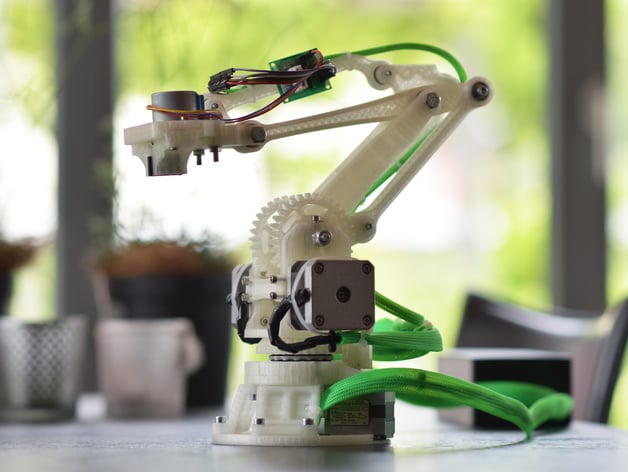
RobotArm
thingiverse
This is a cutting-edge 3D Printable Robot Arm. It may require more time to build than your average weekend project, but the payoff is worth it. The real challenge lies not in building it, but in creating a custom application environment that showcases its capabilities. Learning, combining, and developing innovative applications are what make this robot truly special. Community There's already an active community working on derivative projects and improvements. Be sure to check out their work! You can also enhance your RobotArm build with features like end switches and belt drives. 20sffactory has created a support group on Facebook at https://www.facebook.com/groups/828749637471209, where you can connect with other enthusiasts. They've also developed a Python voice control project, which you can find on Github at https://github.com/20sffactory/voicebot_opensource. Hardware The primary goal of this design was to create a robust and powerful robot that's both compact and easy to handle. The NEMA17 Step Motors provide ample power for swift movements and precise control. Almost every joint has at least one ball bearing to minimize friction, ensuring stability and accuracy. To keep the robot grounded, it's powered by a computer power supply (12V). The gripper is easily replaceable and held horizontally in every position, simplifying programming and reducing costs. Most parts have an industrial look, similar to cast iron components. Software The software for this robot is now available on Github at https://github.com/ftobler/robotArm/. It's built using Delphi and provides a simple interface for controlling the robot. The code includes some bug fixes to address connection issues. Desktop Software A desktop application has been written to control the robot, offering basic operations that can be expanded into a comprehensive software project. RobotArm_Software_v2.zip contains updated code with bug fixes, including improved connection reliability. GCODE Valid GCODE commands have spaces between them and follow this format: G1 X0 Y120 Z120. The G0=G1 command moves the XYZ axes in mm (cartesian) at a speed of F mm/s, using absolute coordinates. Unlike 3D printers, there's no E-axis, and every move includes acceleration and deacceleration. Desktop Software Interface A simple desktop application has been created to control the robot, providing basic operations that can be expanded into a comprehensive software project. The software is written in Delphi and offers a user-friendly interface. Parts List This is an approximate count of nuts and bolts required for the robot, excluding any additional washers or screws needed. Please note that this list is not exhaustive, and you may need to purchase more parts. * M3x6: 16 * M3x8: 21 (3 used as set screws) * M3x10: 4 * M3 Washer (large for gripper): 2 * M3 Nut: 4 * M4x10: 6 * M4x16: 11 * M4x25: 2 * M4 Washer (small enough for Bearing): 14 * M4 Nut: 8 * M6 Washer (small enough for Bearing): 12 * M6 Nut: 3 * M6 Self Locking Nut: 3 * M6x45: 3 * M6x80mm Threaded Rod: 1
With this file you will be able to print RobotArm with your 3D printer. Click on the button and save the file on your computer to work, edit or customize your design. You can also find more 3D designs for printers on RobotArm.
